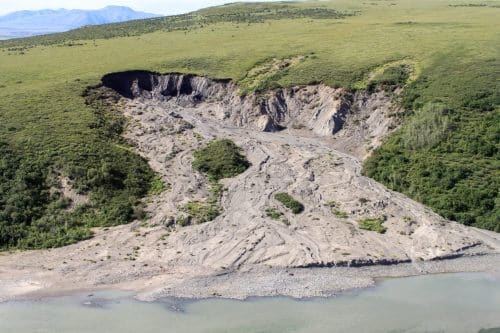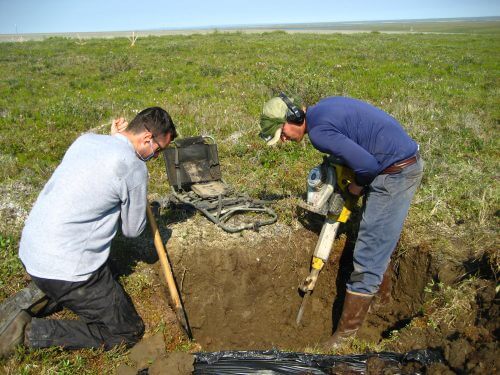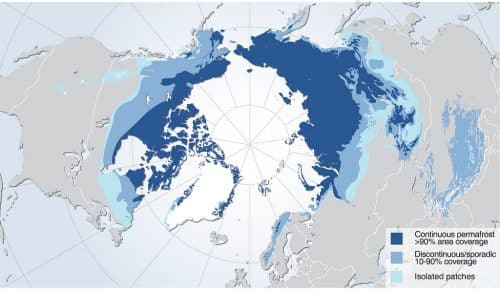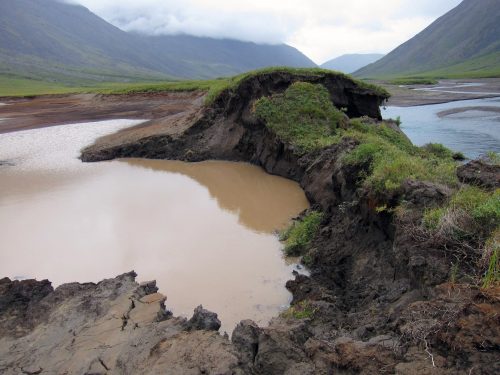The thawing arctic tundra is expected to accelerate climate change for at least a hundred years. The question is: to what extent?

- Permafrost - the frozen ground throughout the year - is thawing in large areas around the Arctic Circle. Bacteria break down plant and animal remains in the warming soil, releasing carbon dioxide and methane into the atmosphere.
- The freezing zone in the north of the Earth is extensive and contains about 1,450 billion tons of organic carbon, almost twice the amount of carbon found in the Earth's atmosphere.
- Data from many sensors indicate that 5% to 15% of this carbon may be released in the current century. If 10% of the carbon is released, 130 to 160 billion tons of carbon will enter the atmosphere and accelerate global warming. Slowing down the overall warming is the best way to prevent or slow down the thaw.
The hard block of ice and snow, weighing about 20 kilograms, which I am holding in my rubber gloved hands, manages to slip and fall from my grasp. The block falls and lands with a thud in the long trench I am digging with five other scientists in the deep snow of the heart of Alaska. I stand on my knees, on the edge of the ditch, and straighten up to rest a little and stiffen my aching lower back, which is protected by a weightlifter's belt. On this bright and cold day, we are digging along a snow fence, the fourth of six slices on a gentle hill slope in the heart of the tundra. We remove tons of snow and drive them away on sleds. This work is part of an experiment designed to warm the ground to simulate the action of the future climate on this remote place nearDenali National Park.
It's the first days of April, and my team has been busy for more than a week removing the piles of snow that the wind swept and compacted along the fences we install every fall at the test site. Each fence is about one and a half meters high and eight meters long. The extra snow piled up along fences insulates the ground like a blanket from the cold winter air and leaves the surface of the ground, which normally remains frozen year-round, at a higher temperature than it would have reached without it. We remove the excess snow so that the spring affects the experimental plots at the same time as it reaches the surrounding tundra soil and so that the additional water that will be created as a result of the spring thaw does not seep into the soil and change the quality of the soil compared to the soil of the area.
Keeping the frozen ground at a higher temperature in the winter causes it to thaw earlier in the summer and at a higher rate. This reaction is exactly what is expected to happen when the temperature rises in the Arctic Circle and in the northern ecosystems that border it with climate change. The temperature increase there is twice as fast as the average rate of temperature increase in the world. The land in the stagnant areas of the witness (permafrost) consists of rocks, frozen soil and ice, therefore it melts, and does not break, when it heats up. Like a hamburger that is taken out of the freezer, it softens but does not become liquid. When the frozen ground thaws, bacteria that were frozen in it return to activity and break down the remains of vegetation and animals that have accumulated in the frozen ground for hundreds of thousands of years, emitting carbon dioxide, CO2, and methane, CH4.
The stagnant stasis zone that encircles the northern part of the earth like a ring contains a huge amount of organic matter. The amount is so large that even releasing a small portion of it into the atmosphere as greenhouse gases could dramatically increase the rate of global warming. Our experiment in Alaska is an important part of an integrated series of studies being conducted around the world with the aim of assessing the magnitude of the impact of this thaw over the next decades. We are starting to know the data enough to make solid predictions.
Huge amounts may thaw

How is it possible to numerically estimate the frozen area that will thaw, the rate of thawing and the extent of the effect of the carbon that will be emitted as a result on global warming? The quantification will have to take into account a significant part of the earth's surface. The freezing zone covers about 16.7 million square kilometers in the northern half of the planet, almost a quarter of the land surface that is not covered by ice. The depth of the frozen ground can reach tens or even hundreds of meters. (Most of the southern regions of the Earth are covered by oceans or a ground ice sheet, so the area of frozen land there is not large.)
Satellites and remote sensing devices can accurately record changes in the solid ice cover, such as the one in Greenland, but there is no such comprehensive system of remote sensing to record frozen areas. For years, scientists have tracked sensors installed in certain locations in the witness stasis zones, but we just didn't have enough data points around the world. However, we have been adding sensors all the time. Today, the global terrestrial network for tracking the stasis of the witness, (GTN-P) follows more than a thousand boreholes equipped with devices that record the temperatures down to a depth of several meters in the ground, and even deeper than that.
The network showed that the frozen regions have been warming at a uniform rate for the past decades, and in many places the temperature reached new highs in 2014 and 2015. The sharpest increases were in places where the ground temperature was all years very low, between 5 and 10 degrees below zero. We have also seen a warming of the witness freeze in areas where the temperature is closer to the freezing point, between minus 2 and 0 degrees Celsius, where a change of one degree can have a big impact. In some places where the temperature of the frozen ground is close to the freezing point, there is a condensation of the active layer, that is, of the upper layer of the soil, which thaws in the summer and freezes in the winter. When you add the measurements from all over the world, you get a good idea of the changes in ground temperature across the Arctic.
The proportion of stagnant land that may thaw is only part of the calculation we want to make. We also want to know how much organic matter the softening soil contains. Last spring, at the research site inEight Mile Lake, my team drilled six feet deep into the ground to extract soil cores, as we have done every few years since the project began more than a decade ago. Our measurements and those of others throughout the tundra show that the top cubic meter of soil contains about 50 kilograms of organic carbon associated with frozen organisms that have undergone partial decomposition (as opposed to inorganic carbon which is part of the rock and is unlikely to undergo any change even if the temperature rises). This amount is about five times greater than the amount of carbon in the soil in the same area that is not frozen. The amount of carbon is approximately 100 times greater than that stored in shrubs and plant species that manage to grow in the Arctic Circle.
Organic carbon may also be found at a depth of tens of meters. In total, the researchers estimate that the frozen soil in the north of the Earth contains between 1,330 and 1,580 billion tons of organic carbon, almost twice the amount of carbon in the Earth's atmosphere. The top three meters of the soil in the freeze zones in the north, alone, contain about 50% of the amount of carbon found in the top three meters of the soil in the rest of the world, even though the freeze zones are only about 15% of the world's land surface.
The scientists also began to measure the amounts of organic carbon found in permanently frozen places that had not been measured until now, such as the bottom of very shallow sea areas scattered along the Arctic coasts. The stagnant soil found there undergoes slow decomposition as the seawater penetrates it, and it is not yet clear how much organic carbon it contains. Carbon is also abundant in thick layers of sediments found in the vast deltas of Arctic estuaries, but we just haven't measured many sites. The best estimate we have right now is that another 400 million tons of carbon are buried in these various places.
How much and at what rate?
In view of the huge amounts of organic carbon buried in the frozen ground, it seems likely that the thaw could release very large amounts of greenhouse gases. Determining a numerical value for this release rate depends on three key questions.
First, how much of the carbon can become greenhouse gases? Microorganisms can easily digest some of the carbon and release it, but not all of it. Therefore, a certain part of the carbon will simply remain in the soil because it is completely inaccessible or inedible to bacteria.
Second, at what rate can the bacterial action release the gases? Carbon from sources that the bacteria decompose quickly can be released into the air within less than a year of the thaw, but it is likely that more carbon will be gradually released over decades after the thaw, partly because it is found in semi-decomposed sources, and the completion of the decomposition by the bacteria is slow.
The third question is: what greenhouse gases will the bacteria release? The relative amounts of carbon dioxide and methane will ultimately determine the climate warming potential. Waterlogged, low-oxygen soils (called "anaerobic or non-aerobic environments") such as peat bogs, for example, usually produce much more methane than carbon dioxide. The effect of methane on global warming over a century is about 33 times greater than the effect of carbon dioxide in the same amount.

We monitor the release of gases at research sites such as the Eight Mile Lake and the tundra in its vicinity with the help of gas sensors operating in the infrared range that measure the concentrations of gases in the air over seconds, days, seasons and years. The tundra in the Eight Mile Lake area probably releases more carbon into the atmosphere than it absorbs. The heating of the ground due to the snow along the fences helps the plants grow faster and reach a larger size, and thus more carbon dioxide is absorbed from the air and stored. But it also helps the bacteria break down more carbon found in the soil. In the summer, the increased growth is completely offset by the increased release from the soil, but the activity of the bacteria during all the long autumn and winter months, when the plants are dormant, tips the scale in favor of the release into the atmosphere, which exceeds the absorption in the general calculation.
From a comparison between our findings and findings from other experiments in the world, we conclude that the thawing of ice stasis emits excess carbon into the atmosphere. The collected data are compiled by the researchers inOnline repository One called "The carbon chain in the deadlock". Just like in the parable of the blind men describing an elephant, each group of researchers conducting field experiments around the Arctic Circle has a unique piece of information. Together, these pieces of information create the knowledge about the scope and nature of this phenomenon. The online database also consolidates scientific findings for reports, authority updates and media interviews to inform decision makers and the general public and allow all these bodies to decide what to do about our changing world.
Such a recent project, which summarized information from several sources, helped to answer the question of the relative amounts of carbon dioxide and methane that will be emitted. In aerobic conditions (dry soil) the bacteria mainly release carbon dioxide. But in anaerobic conditions that prevail in swamps and peat, they release both carbon dioxide and methane. Christina Shedel from Northern Arizona University, a key member of the Carbon Freeze Network that also works with my group, studied how this balance could ultimately affect the climate.
Unlike our studies which are based on experiments in the field, Shedel relied on experiments in which they brought frozen soil to the laboratory and heated it in glass cells. The controlled experiment makes it possible to measure exactly the amount and the rate at which the carbon from the soil is converted into carbon dioxide or methane. She used statistical tools to combine data from similar experiments done around the world and found that, by weight, carbon dioxide is the main greenhouse gas released from any type of soil sample, whether taken from an aerobic or anaerobic environment. Amazingly, greenhouse gas emissions from aerobic decomposition affect the climate twice as much as emissions from anaerobic decomposition, even though methane, which is only released from an anaerobic environment, is a stronger heater.
This means that thawing of permafrost in well-drained and relatively high elevation areas will likely affect the climate more than thawing by a similar amount in low-lying, flooded areas. While methane is still a major factor in the equation, the general distribution of high and low areas in the Arctic landscape will largely determine the impact of the frozen ice's expected thaw on the climate.
Accelerating climate change
By combining data from field studies and laboratory tests and combining the information with the help of computer simulations of future climate scenarios, the frozen carbon network found an answer to the question of how thawing is expected to affect the climate. According to the members of the network, the experts in the field, probably between 5% and 15% of the carbon stock in the current stagnation will be released in this century, mainly as carbon dioxide.
To the best of our knowledge, according to the middle value of 10% of the carbon stock, 130 to 160 billion tons of carbon will be added to the atmosphere. Such an amount, if released in the form of carbon dioxide at a uniform rate for a hundred years, is similar to the amount of carbon that has been released in the world so far due to deforestation and other changes in land use, but is much smaller than the emissions caused by burning mineral fuels. The thawing of the ice freeze will cause climate change to occur even faster than scientists' estimates based only on emissions caused by human activity predict. And it is likely that carbon emissions from the current stagnation will continue even after the end of the century. Every additional ton of carbon released into the atmosphere from the thawing Arctic region will exact an additional price from human society.
Reducing the thawing of the ice stasis with all kinds of local fixes throughout the Arctic is not a practical option. The only real solution is to limit emissions from burning fossil fuels and from deforestation to slow overall global warming. This will also reduce emissions from the Arctic thaw, and give communities around the world more time to adapt.

The estimate of the carbon release rate described above, of 5% to 15%, was first received only in 2016. We still do not have a comprehensive system of observations in the stagnation zones, based on which we can get a more solid forecast. Additional sensors will allow us to detect both slow and fast change, which can cause less or more concern. They will also help us discover important surprises that may pop up.
New initiatives, such as the Arctic region project as part of the Next Generation Experiments in Ecosystems initiative (NGEE) of the US Department of Energy and the Northern and Arctic Vulnerability Experiment (ABOVE) of NASA help to fill wide gaps in modeling and expand the measurements in the field, such as those conducted in and around the Eight Mile Lake, and eventually bring them to a global scale.
One of the most intriguing and crucial questions is whether extensive plant growth can counteract the increase in the rate of carbon release. The latest simulations tend to show that longer growing seasons, higher temperatures, and the enrichment of nutrients from the thawing soil and the natural transition to trees and faster growing plants, may be able to balance the release of carbon from the stagnation witnessed this century. But this estimate contradicts the measurements from the Eight Mile Lake and other sites, which show a net release of carbon over an entire year.
It would also be useful to have better simulations of the settling process of the thawing soil. This is definitely missing in the large-scale models that simulate the interrelationship between the carbon in the current stagnation and the climate. As the ice in the permafrost thaws and drains, the ground sinks, causing it to thaw more suddenly. Will widespread subsidence increase emissions from the current stagnation even more?
My colleague and I observed this phenomenon right at the Eight Mile Lake when we returned there in the spring of 2016. The sidewalks we built almost ten years ago, along with the gas flow measurement sensors and other equipment we installed, were warped and distorted due to the ongoing subsidence of the land. The ground under the sidewalks was undulating and potholed.
The spring 2016 thaw in the Eight Mile Lake region was also deeper than ever: more than a foot in some spots, a rate we've typically only seen in late summer. These abnormal measurements parallel other extreme values measured in the Arctic region: a record, early-season retreat of the ice sheet covering the Arctic Ocean, early melting of snow in the northern hemisphere and early melting of the surface of the Greenland ice sheets. Carbon emissions from stagnation are already happening. The release of the gases will not occur in a quick burst that could suddenly change the climate, as some feared. But it will be extensive, will last over decades and will greatly complicate the challenge facing human society to slow down global warming.

3 תגובות
The solution is much simpler than carbon-eating bacteria, which do not yet exist, this solution is called to stop using carbon fuels, how much to stop? Totally. In which areas to stop? Also in industry, both in electricity production and in vehicles. When to stop, immediately.
"Could"?
For years I have been asserting with certainty that the melting of the polar snow will bring about the end of humanity. clear and smooth.
Here's the explanation:
Place a bucket full of a mixture of ice and water on the fire. What will happen?
At first - nothing. The water temperature is zero degrees. As you continue to heat the water - the temperature will remain zero. Only the ice is melting.
And what will happen when all the ice melts? Or then the temperature will skyrocket at once.
Something is wrong on Earth. Greenhouse Effect? Maybe. There is a precedent for this in the planet Venus. The arctic snow is melting, just like a bucket. We sit in the bucket, complacent, along with the genius Trump who is sure that global warming is a Chinese conspiracy. And what stupid government mechanism allows him to impose his opinion.
And everything is fine. Meanwhile.
It sounds like the solution lies in engineering carbon-eating bacteria so that they reduce its amount in the atmosphere, but those that can be disposed of in a controlled manner in the future so as not to be left with a lack of carbon.